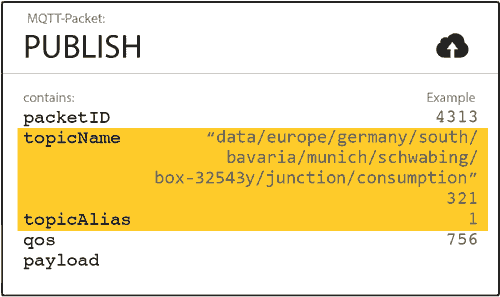MQTT Topic Alias – MQTT 5 Essentials Part 10
Welcome to Pat 10 of our MQTT 5 Essentials series. Building upon our previous discussion in Part 9, where we unraveled the Request - Response Pattern, we now direct our attention to another potentially impactful feature: Topic Alias.
What is MQTT Topic Alias?
Topic Aliases are integer values substituting topic names. It enables you to condense a lengthy and frequently utilized topic name into a 2-byte integer. This helps minimize the amount of bandwidth consumed during message publication.
Senders define the Topic Alias value in the PUBLISH message, followed by the topic name. Receivers then process this message like any other PUBLISH, establishing a mapping between the Topic Alias (integer) and Topic Name (string). Subsequent PUBLISH messages for the same topic can be sent with just the Topic Alias, omitting the topic name.
Why Use Topic Aliases in MQTT?
MQTT plays a pivotal role in your network with its efficiency in maintaining standing connections between your devices and the MQTT brokers. The Keep Alive mechanism guarantees the longevity of connections between clients and the broker, swiftly detecting any connection loss that could occur in unstable networks. PING packets - of just two bytes - need to be sent only every few minutes, enabling MQTT to sustain these connections with minimal power and bandwidth use.
This brings us to the Topic Alias feature, which is particularly beneficial in deployments involving a vast array of connected devices transmitting smaller, frequent messages. So, let’s dive into this feature and see how it can optimize your MQTT 5 utilization.
How to Use MQTT Topic Names?
The MQTT client and the broker have the power to establish a Topic Alias for any PUBLISH message, provided they are the message’s originator. Similarly, they can control the number of Topic Aliases permitted for each connection. The upper limit for Topic Aliases, known as the Topic Alias Maximum, is determined during the connection establishment phase.
The client indicates its Topic Alias Maximum in the CONNECT packet, while the broker does so in the CONNACK packet. Therefore, the client should only utilize Topic Alias values ranging from 1 to the broker-defined Topic Alias Maximum presented in the CONNACK packet. Similarly, the broker should respect the range of 1 to the client-defined maximum from the CONNECT packet.
In the absence of a specified Topic Alias Maximum, a default value of 0 is assumed, which effectively disables the use of Topic Aliases. This ensures clear communication boundaries and precise control of Topic Aliases within your MQTT deployment.
Use Case Examples of MQTT Topic Alias
MQTT stands out as a lightweight communication protocol that efficiently maintains TCP connections between clients and brokers. Its Keep Alive mechanism minimizes energy and bandwidth usage, enabling users to establish cost-effective, always-connected device deployments. Moreover, it allows for real-time delivery of minimal data points, like measurements, negating the need for periodic bulk data transfers – a requirement of heavier data transfer technologies.
This inherent efficiency of MQTT finds utility in numerous applications, such as predictive maintenance, where the service’s quality and responsiveness can be enhanced by transmitting small data points in real time. In these situations, an elaborate topic name might be more sizable than the actual data payload, which a single integer could represent. For instance, a topic name like 'data/europe/germany/south/bavaria/munich/schwabing/box-32543y/junction/consumption/current' describes the current power consumption of a specific junction box, with the payload being a single integer value.
 Topic Alias can substitute long and complex topic strings with single integers.
Topic Alias can substitute long and complex topic strings with single integers.
The Topic Alias feature of MQTT comes to the fore in these instances, replacing lengthy and complicated topic strings with single integers. This technique is especially useful when sending numerous small messages over extensive topic names in real time, offering two primary advantages: It amplifies performance while significantly reducing network traffic. Hence, Topic Alias becomes a powerful tool in your MQTT 5 arsenal, optimizing data transmission and network management.
Understanding MQTT Topic Alias
Topic Aliases substitute UTF-8 String topic names with an integer.
Topic Alias to Topic mapping is relevant only for a single connection.
This feature’s support is optional for brokers and clients.
Broker and client negotiate to what degree this feature is supported during the connection establishment.
Ensure your broker and client implementation supports Topic Aliases if you wish to use this feature.
When used correctly, Topic Aliases can significantly impact the profit margins of your business case.
Let us know about a use case that you think Topic Aliases can be very useful for in the comments!
Conclusion
Topic Alias offers a versatile approach to utilizing the pub/sub model. When repeatedly publishing messages to a limited number of topics, particularly in high volumes, Topic Aliases can significantly conserve network and computing resources in an efficient manner. In the next article, we will discuss Enhanced Authentication.
Sign up for our newsletter to get regular updates. Subscribe to our RSS feed here to stay updated. We encourage you to visit our MQTT Glossary for an in-depth understanding of the essential MQTT terminologies. It will equip you with the necessary vocabulary to grasp the complexities of MQTT and its various versions. Watch the video below that complements the concepts discussed in this article.

